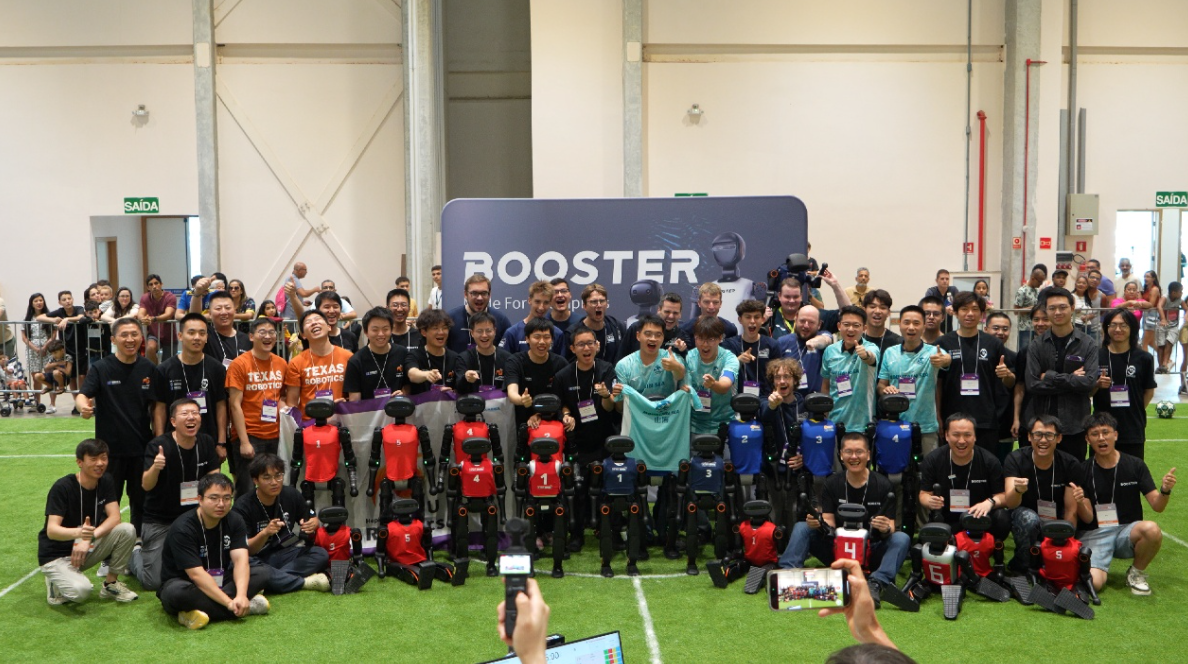On Sunday, the 2025 RoboCup Humanoid League finals came to an end in Brazil. In a thrilling match, Tsinghua University’s Hephaestus team defeated China Agricultural University’s Mountain Sea team 5-3 to win the championship. This victory made history: it was the first time China had claimed the gold medal in the 28-year history of the Humanoid AdultSize Soccer Competition at the event.
Chinese teams performed exceptionally well right from the group stage. The Hephaestus team, using China’s home-developed T1 humanoid robots, dominated their opponents. They achieved several big wins without letting the other side score, including 16-0, 9-0, and 12-0 victories over the US team UT Austin Villa. A memorable moment in the group stage was when one of Hephaestus’ robots scored the “best goal” of the tournament. It copied the famous diving header by Dutch footballer Robin van Persie: the robot judged the ball’s path near the goal, jumped forward, and headed it into the net. People called this exciting goal the “robot Van Persie dive.”
Other Chinese teams also did well. Tsinghua University’s TH-MOS team took second place in the KidSize category. In the KidSize final, both the German team Boosted HTWK and China’s TH-MOS used the K1 robot. What’s worth noting is that many teams, including those from Germany and the US, chose Chinese-made robots like T1 and K1.
RoboCup, started in 1997, is the world’s top robotics competition. It’s famous for its large scale, high reputation, and strict technology requirements. Among all its events, the Humanoid category gets the most attention. According to its official website, RoboCup has a big goal: “By the middle of the 21st century, a team of fully independent humanoid robot soccer players will win a football game against the recent World Cup champion, following all FIFA’s official rules.”
Many teams from the 2025 RoboCup are expected to join the first World Humanoid Sports Games. This event will be held in Beijing in August, and it will feature the world’s first 5v5 AI robot soccer game.
原创编写 版权所有 侵权必究! 每日更新 个性化阅读 英语飙升!
1.1.Why is China’s victory described as “making history”?
A Because of the highest-scoring final.
B Due to the first-ever gold medal.
C Due to the youngest winning team.
D As a result of the fastest goal record.
解析:选B。B 推理判断。根据第一段的“first time China has won gold in 28-year history”可知,创造历史是因为这是自RoboCup开赛28年以来,中国战队首次在含金量最高的人形组摘金。故选B。
2.2.What primarily demonstrates Hephaestus’ dominance?
A Multiple shutout victories.
B Advanced German robots.
C FIFA coaching strategies.
D Host country advantages.
解析:选A。A 细节理解题。根据第二段“16-0, 9-0, 12-0 triumphs”可知,清华火神队使用加速进化T1机器人,以16:0、9:0、12:0的大比分多次“零封”对手,即占据主导地位。故选A。
3.3.What key fact indicates Chinese robots’ global influence?
A TH-MOS developed K1.
B German teams used K1.
C All teams chose T1.
D US won KidSize category.
解析:选B。B 推理判断题。第三段“German champions Boosted HTWK... relied on K1”证明国际强队采用中国技术。反映了中国机器人的国际影响力。故选B。
4.4.What is RoboCup’s fundamental mission?
A Hosting annual human-robot matches.
B Developing entertainment robots.
C Creating FIFA-certified players .
D Beating human World Cup winners.
解析:选D。D 细节理解题。根据第四段“By the middle of the 21st century...following all FIFA’s official rules.”可知,RoboCup的终极目标是到21世纪中叶,一支完全自主的人形机器人足球队,在符合国际足联官方规则的足球比赛中,击败最近一届人类世界杯的冠军。故选D。
